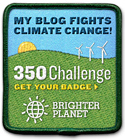When making a big purchase we usually take some time to consider our options, and we always ask lots of questions about the product: what company made it? (ie. what kind is it), where did it come from? how was it made? (what materials were used), what's inside?, etc.
These are all important questions that we need to ask before purchasing, say,a computer.
So, why don't we ask these same questions when purchasing our food. Buying food may not cost as much as a computer, but we are putting it inside of our bodies.
When I say food, I am thinking mainly of meats; cow, pig, and specifically fish. In a world where the fish populations are rapidly decreasing, it amazes me that local supermarkets and restaurants still stock their shelves with 'Fresh Fish' on a daily basis - and customers continue to buy it with no questions asked. The list of questions above can easily be applied when purchasing fish, and your local market or restaurant should be able to provide you with some answers.
Let's quickly go through some of these questions regarding fish and the reasons why they are important to ask.
1. What kind is it? This is the first question that you should ask, especially when it comes to fish like tuna: is it bluefin, yellow tail, big eye... Asking this question allows you to make an ethical choice; was that Atlantic halibut really worth eating if you know that it is a long lived species that matures slowly and abundance has been extremely low. This is an important question as it allows the customer to make a healthy decision and also informs the restaurants and markets that people are looking for answers and sustainable products.
2.Where did it come from? This is an important question because you will be told whether the fish is farmed or wild caught and what body of water it was taken from. Some people believe that eating farmed salmon is a sustainable alternative to wild caught salmon; however, it is important to remember that farmed fish are usually fed with feed made from wild fish, they are usually given antibiotics and vaccines to fight the infections that occur in farmed fish, and the large pens also create water pollution. When ordering salmon the best option is Alaskan Salmon, which is managed well and has a fairly healthy habitat.
3.How was it caught? The answer to this question will provide you with information regarding how much damage was done to ocean life in order to catch your fish. Bottom trawls, longlines, dredges, midwater gillnets, and pelagic longline are the ones to stay away from. These methods of capture have a negative impact on habitat, both physically and biologically, and they also produce high bycatch volumes. The methods of capture with the lowest impact on the ocean are hook and line, purse seines, and midwater trawls.
4. What's inside? With this question you are not literally asking about what is inside the fish, but about what kind of pollutants are in the fish. If the fish was farmed, was it pumped full of antibiotics? If it was wild caught what are the common mercury levels in the species.
Here is a list of websites that are very helpful when trying to find information about edible fish:
www.seachoice.org (Canadian)
www.blueocean.org
www.fishbase.org
www.fao.org
www.mbayaq.org
www.redlist.org
skip to main |
skip to sidebar


Cod, A biography of the fish that changed the world. By, Mark Kurlansky

This work is licensed under a Creative Commons Attribution-Noncommercial-No Derivative Works 3.0 Unported License.
Taking a look at the environmental footprints that we have left behind as well as the road ahead.
What do you know about the fish you are eating?
Posted by
Kait
on Saturday, 26 September 2009
Labels:
fish,
seafood,
water

About Me

- Kait
- I am a 20 something Canadian woman currently living in Vancouver. I am greatly interested in assisting in the search for solutions for global environmental sustainability. It's time we all took personal responsibility for the state of our environment.
Search this blog
Currently Reading...

Cod, A biography of the fish that changed the world. By, Mark Kurlansky
Books of '11
- • Four Fish. By, Paul Greenberg
- • Environmental Law. By, Jamie Benidicson
- • Long Term Value Strategy for the Canadian Lobster Industry. By, Gardner Pinfold Market Research Associates
Books of '10
- • Fisheries Economics an introduction. By, Stephen Cunningham, Michael R. Dunn, and David Whitmarsh
- • Tar Sands. Dirty Oil and the Future of a Continent. By, Andrew Nikiforuk
- • Guns, Germs, and Steel. The Fates of Human Societies. By, Jared Diamond.
- • The End of Food. By, Paul Roberts
Books of '09
- • Silent Spring. By, Rachel Carson
- • Sea Sick, the Global Ocean in Crisis. By, Alanna Mitchell
- • The world without us. By, Alan Weisman
- • Bottomfeeder. How to eat ethically in a world of vanashing seafood. By, Taras Grescoe
- • Life in 2030: Exploring a Sustainable Future for Canada. By, John B. Robinson
- • The Whale Warriors. The battle at the bottom of the world to save the planet's largest mammals. By, Peter Heller
- • In a perfect ocean. The state of fisheries and ecosystems in the north atlantic ocean. By, Daniel Pauly and Jay Maclean
- • The end of the line. How overfishing is changing the world and what we eat. By, Charles Clover
Favorite Posts
Labels
- climate change (5)
- coast (1)
- Dear Korea... (2)
- energy (2)
- finning (2)
- fish (10)
- fisheries (9)
- garbage island (2)
- green building (1)
- Guest post (2)
- hypoxia (1)
- Interesting people (5)
- longlines (1)
- movies (1)
- ocean (19)
- organic (1)
- paper (3)
- plastic (4)
- recycling (6)
- seafood (6)
- shark (2)
- water (4)
- whales (1)
Blog Roll
Followers
Visitors

This work is licensed under a Creative Commons Attribution-Noncommercial-No Derivative Works 3.0 Unported License.







1 comments:
Did you know that you can shorten your links with BCVC and get dollars for every click on your shortened links.
Post a Comment